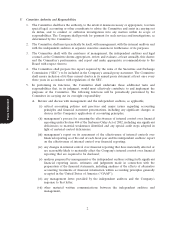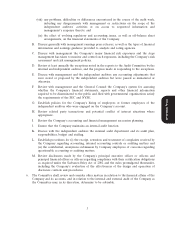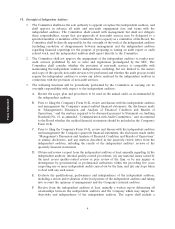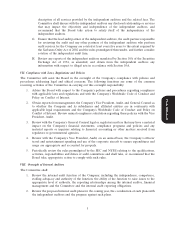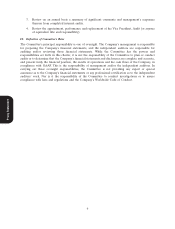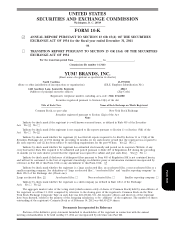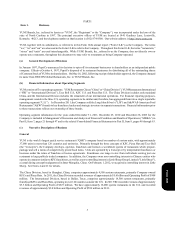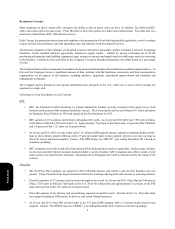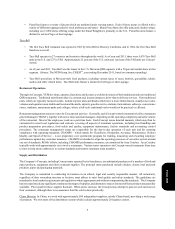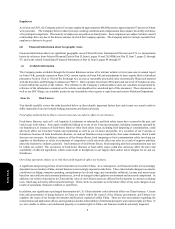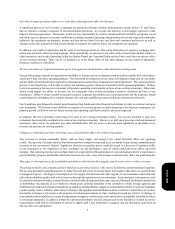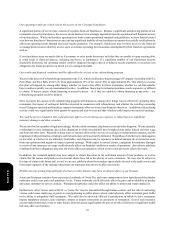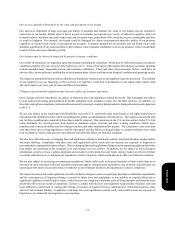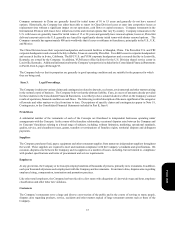Pizza Hut 2011 Annual Report Download - page 109
Download and view the complete annual report
Please find page 109 of the 2011 Pizza Hut annual report below. You can navigate through the pages in the report by either clicking on the pages listed below, or by using the keyword search tool below to find specific information within the annual report.
5
• Pizza Hut features a variety of pizzas which are marketed under varying names. Each of these pizzas is offered with a
variety of different toppings suited to local preferences and tastes. Many Pizza Huts also offer pasta and chicken wings,
including over 3,000 stores offering wings under the brand WingStreet, primarily in the U.S. Pizza Hut units feature a
distinctive red roof logo on their signage.
Taco Bell
• The first Taco Bell restaurant was opened in 1962 by Glen Bell in Downey, California, and in 1964, the first Taco Bell
franchise was sold.
• Taco Bell operates in 27 countries and territories throughout the world. As of year end 2011, there were 5,670 Taco Bell
units in the U.S. and 275 in YRI. Approximately 21 percent of the U.S. units and 1 percent of the YRI units are Concept-
owned.
• As of year end 2011, Taco Bell was the leader in the U.S. Mexican QSR segment, with a 50 percent market share in that
segment. (Source: The NPD Group, Inc./CREST®, year ending December 2011, based on consumer spending)
• Taco Bell specializes in Mexican-style food products, including various types of tacos, burritos, quesadillas, salads,
nachos and other related items. Taco Bell units feature a distinctive bell logo on their signage.
Restaurant Operations
Through its Concepts, YUM develops, operates, franchises and licenses a worldwide system of both traditional and non-traditional
QSR restaurants. Traditional units feature dine-in, carryout and, in some instances, drive-thru or delivery services. Non-traditional
units, which are typically licensed outlets, include express units and kiosks which have a more limited menu, usually lower sales
volumes and operate in non-traditional locations like malls, airports, gasoline service stations, train stations, subways, convenience
stores, stadiums, amusement parks and colleges, where a full-scale traditional outlet would not be practical or efficient.
Restaurant management structure varies by Concept and unit size. Generally, each Concept-owned restaurant is led by a restaurant
general manager (“RGM”), together with one or more assistant managers, depending on the operating complexity and sales volume
of the restaurant. Most of the employees work on a part-time basis. Each Concept issues detailed manuals, which may then be
customized to meet local regulations and customs, covering all aspects of restaurant operations, including food handling and
product preparation procedures, food safety and quality, equipment maintenance, facility standards and accounting control
procedures. The restaurant management teams are responsible for the day-to-day operation of each unit and for ensuring
compliance with operating standards. CHAMPS – which stands for Cleanliness, Hospitality, Accuracy, Maintenance, Product
Quality and Speed of Service – is our proprietary core systemwide program for training, measuring and rewarding employee
performance against key customer measures. CHAMPS is intended to align the operating processes of our entire system around
one set of standards. RGMs’ efforts, including CHAMPS performance measures, are monitored by Area Coaches. Area Coaches
typically work with approximately six to twelve restaurants. Various senior operators visit Concept-owned restaurants from time
to time to help ensure adherence to system standards and mentor restaurant team members.
Supply and Distribution
The Company’s Concepts, including Concept units operated by its franchisees, are substantial purchasers of a number of food and
paper products, equipment and other restaurant supplies. The principal items purchased include chicken, cheese, beef and pork
products, paper and packaging materials.
The Company is committed to conducting its business in an ethical, legal and socially responsible manner. All restaurants,
regardless of their ownership structure or location, must adhere to strict food quality and safety standards. The guidelines are
translated to local market requirements and regulations where appropriate and without compromising the standards. The Company
has not experienced any significant continuous shortages of supplies, and alternative sources for most of these products are generally
available. Prices paid for these supplies fluctuate. When prices increase, the Concepts may attempt to pass on such increases to
their customers, although there is no assurance that this can be done practically.
China Division In China, we work with approximately 500 independent suppliers, mostly China-based, providing a wide range
of products. We own most of the distribution system which includes approximately 20 logistics centers.
Form 10-K



